Table of Contents
- Types of ribbon foundation
- Is it necessary to do waterproofing of the ribbon foundation?
- Waterproofing technology
- Types of waterproofing
- What can be done if waterproofing has not been done for the ribbon foundation?
- How to do best waterproofing of the ribbon foundation with your own hands?
- The price of waterproofing of a ribbon foundation
- Calculator for self-calculation of the cost of waterproofing
A foundation — is a structure that takes on the load of a constructed building and transfers it to the foundation. The foundation may be of several types, among them is a ribbon one. This type is very popular in private construction, since its construction involves quite reasonable costs and simple construction technology.
The installation of a ribbon foundation is fairly simple process, the main thing is to study some technological features. It is advisable to lay the ribbon in a shallow way of laying on dry non-porous soils, and if the soil on the site freezes deeply, then the construction of a ribbon foundation is more expensive due to the large amount of excavation work associated with the deepening of the ribbon.
Types of ribbon foundation
Choosing the type of foundation is crucial, as it is an important structural element of the entire building. If a mistake is made at the beginning of construction, that is, the foundation is improperly planned or made, then this can lead to a serious consequences. It may have distortions, deformations, deposits and cracks in the supporting structure.
Ribbon foundations have several main types:
1. Shallow (shallow) – Shallow ribbon foundation is optimally suited for light structures: wooden houses, foam concrete and frame houses, as well as small brick ones. It is located on slightly pubescent soils, its depth is about 50-70 sm.
The technology of the installation of fine-grained ribbon and its parameters:
| Parameters | Degree of heaving properties | ||
| Highly frost-susceptible soils | Medium frost susceptible | Low frost-susceptible | |
| The thickness of the cushion protecting against heaving soils | 0,4m | 0,2m | 0,1m |
| The depth of the trench under the ribbon | 0,7m | 0,5m | 0,4m |
| The width of the trench under the ribbon | 0,8-1,3m | 0,7-1,3m | 0,7-1,2m |
The scheme of laying a shallow-buried ribbon foundation

The installation scheme of a fine-grained ribbon:

2. Deep-laid– Designed for massive houses and structures located on difficult or heaving soils. In addition, this type of ribbon structure is necessary when planning a basement or garage in a house. Its construction requires more labor and materials, and its depth is 20-30 sm below the freezing point of the soil at an average depth of 1.8-2m. Under the walls inside a house or building, a shallower depth of the ribbon 40-60 sm is possible.
Diagram of the installation of the deep-laying ribbon:
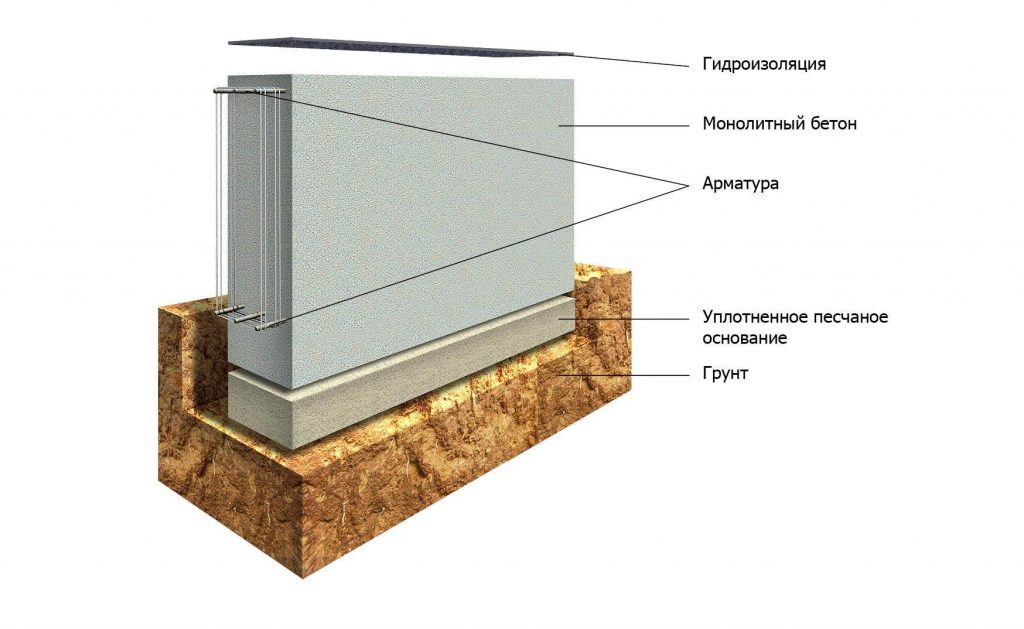

The choice of a belt structure, shallow or deep, depends on the degree of load, the geology of the soil and on the task to be solved, for example, the installation of a basement, socle or garage.
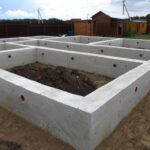
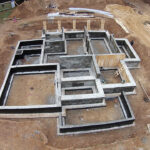

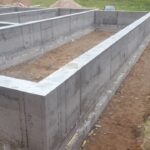
Is it necessary to do waterproofing of the ribbon foundation?
To the question whether waterproofing is needed, there is an unambiguous answer, and it is YES, regardless of whether the house will have a basement or not. Waterproofing is designed to protect the buried part of the ribbon from the effects of water, moisture, salts and minerals in the soil that can eventually destroy concrete.
In the absence of waterproofing, the concrete ribbon base can expect the following consequences:
- Cracks – concrete can crack or collapse as a result of a constant temperature drop, since in the absence of waterproofing, water is absorbed into concrete, freezes in winter, and thaws in spring, forming fractures, microcracks, pores, capillaries and voids in concrete. If the ribbon is left without proper protection, the destruction increases every year, as they overlap each other.
- Destruction – Soil, surface and ground water are aggressive media containing various impurities, minerals and salts, which, in the absence of waterproofing, can destroy the concrete ribbon of the base.
Important: Concrete ribbon is not designed to be constantly in water, to withstand the effects of moisture, various salts, minerals and aggressive environments. The reliability of the foundation is the key to the capital and durability of the structure.
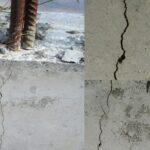
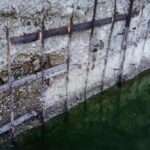
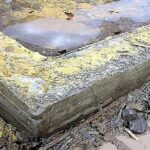

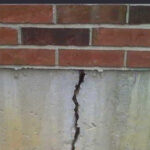
Waterproofing technology
If the tape was made of monolith, then 7-10 days after its filling, it is necessary to remove the formwork and begin work related to waterproofing. When installing a ribbon from blocks, waterproofing can be started as soon as everything is done. Regardless of what material was chosen for the ribbon installation, it needs to be protected both horizontally and vertically.
Horizontal waterproofing
Horizontal insulation serves as a cut-off between the ribbon and the subsequent construction of the slab or walls of the house, that is why horizontal waterproofing is also called cut-off waterproofing. This protection prevents water and moisture absorbed into the concrete from below and capillary rise, forming wet spots and leaks on the cold joints of the junction inside the built basement or socle.
Installation technology:
- Surface cleaning;
- Applying a primer or sealant;
- The installation of a shut-off waterproofing.
You can read more about horizontal insulation in the article – “Horizontal waterproofing of the foundation: The technology of the installation and the materials necessary for this”.
Installation scheme:


Vertical waterproofing
Vertical insulation protects the vertical surface of the ribbon located below ground level from the effects of water and aggressive environment. In the presence of vertical protection, water and an aggressive environment will not be able to exert their negative pressure on the concrete from which the ribbon is made, which will give it the opportunity to serve a large amount of time.
Installation technology:
- Cleaning the vertical surface;
- Applying a primer or sealant;
- The installation of vertical shut-off waterproofing.
You can read more about vertical insulation in the article – “Vertical waterproofing: materials and methods of its installation”.
Vertical protection mounting scheme:

Installation of the drainage system
In the presence of groundwater or swampy soil, it is recommended to make drainage around the ribbon structure. This system will allow to divert water from the base of the tape, which will weaken its pressure on the performed waterproofing, which in turn will extend its service life by 3-4 times. In the presence of groundwater, drainage will protect the structure from erosion and movement, due to which damage and cracks may form.
Important: When installing drainage, it is recommended to install the system at around 30-50 sm below the level of the ribbon, so that it takes over both the water that comes to it and the one that will be under it.
You can read more about the drainage system in the article – “Turnkey drainage installation around the house: Proper drainage, it’s types, installation technologies, schemes and prices”.
Installation scheme of a drainage system for removing water from the foundation:

Types of waterproofing
For waterproofing of the ribbon structure, different materials are used from the simplest bitumen mastic to high-tech systems like liquid rubber. These materials are used to process the ribbon on the horizon, as well as vertically from the outside and inside.
Further, we will study the main waterproofing systems designed to perform waterproofing of the ribbon type of foundation.
Bitumen mastics
Bitumen mastics — are one of the cheapest and easiest ways of waterproofing.
The application of this type of insulation is carried out using a construction roller or brush in 2-3 layers with the drying of the previous one. Mastics are usually supplied in plastic or metal buckets of different weights.
The disadvantage of this method will be its fragility, since bitumen mastics can quickly become unusable under the influence of aggressive soil and water environments, as well as under the influence of seasonal temperature changes.
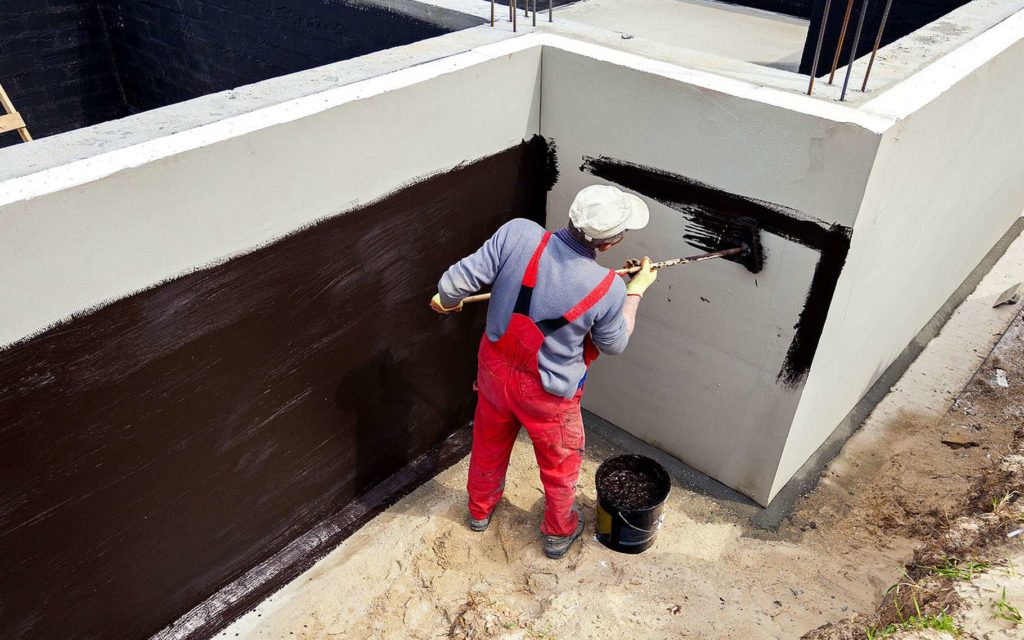
Rolled surfaced and self-adhesive materials
Surfaced and self-adhesive waterproofing is supplied in rolls made of fiberglass, glass-fiber mat, polyester and bitumen-based binder.
Method of application:
Rolls are applied to the surface using a burner by its deposition method. The deposition of the rolls occurs overlapping and at least in 2 layers overlapping the seams of the previous one.
The main disadvantages of roll waterproofing are:
- The presence of seams between the rolls, which eventually diverge and allow water to pass under them, thereby breaking the tightness over the entire surface;
- Lack of adhesion (adhesion) to the surface, so that water can walk under the waterproofing carpet from one place to another.
You can read more about roll waterproofing in the article – “Roll waterproofing installation”.

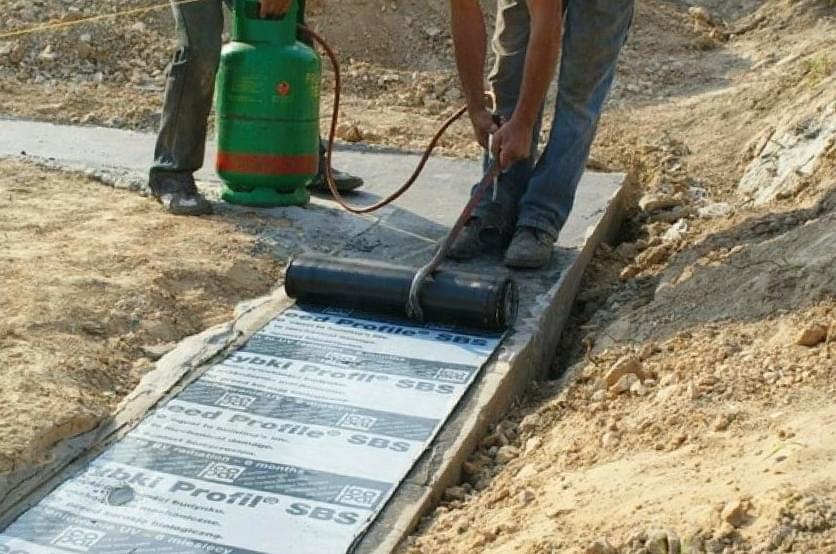
Plaster compositions
Plaster compositions are made on the basis of cement, polymer and acrylic additives. It is various additives and admixes that betray its hydrophobic properties to plaster and cement insulation.
Method of application:
For the application of plaster compositions, spatulas and construction brushes are used. These mixtures are applied by coating on the surface in 1-2 layers.
Disadvantages of the method:
Most cement mixtures do not have a high coefficient of elasticity and may crack when the building shrinks, which will disrupt the waterproofing.
You can read more about cement and plaster waterproofing in the following articles:
- Plaster waterproofing: Types of materials, their characteristics and methods of application
- Cement-based waterproofing: Features, types and methods of its application
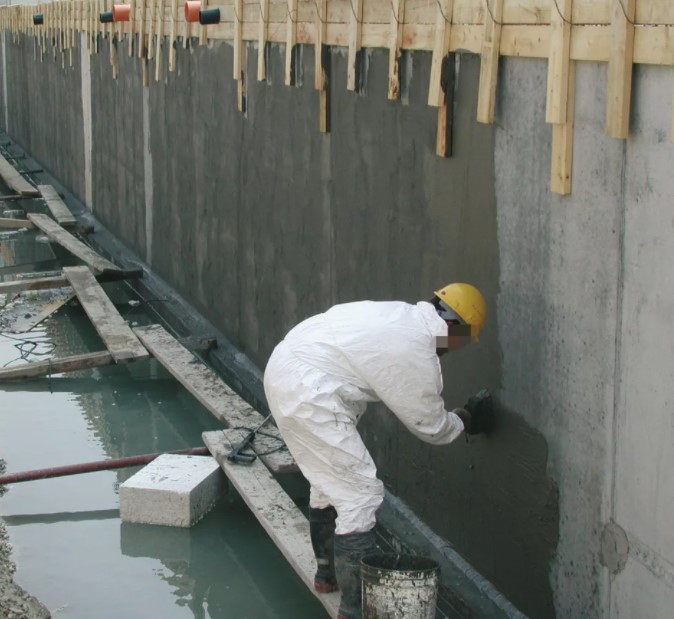
Penetrating compounds
Penetrating products have properties to penetrate into the pores of concrete and small capillaries, contributing to their clogging and preventing the penetration of moisture. These products are mainly used from the inside of the room and in situations where access from the outside is impossible.
Method of application:
A brush or roller is used for application. Before and after coating with a penetrating compound, the concrete should be abundantly moistened. If there is insufficient moisture before the installation and for 5-6 days after the installation, the penetrating systems will not work.

Disadvantages:
Where the porous structure of concrete has large voids or cracks, penetrating systems will not work, that will lead to leaks in problem areas of concrete or FBS blocks despite the waterproofing done.
More information about penetrating compounds can be found in the article – “Penetrating waterproofing: A detailed description of its work on concrete, types of materials and application technologies”
Scheme of work of penetrating mixtures:

Liquid rubber
Liquid rubber — is a reliable and durable protection of the ribbon foundation from moisture, water and aggressive environment. Liquid rubber consists of modified bitumen, latex and various polymers, which gives it such unique properties as:
- High coefficient of stretching and elasticity (more than 800%), which allows the rubber not to diverge and crack when the foundation shrinks or its dynamic movement;
- Complete absence of seams;
- 100% adhesion to the surface.
Method of application:
Liquid rubber can be applied by hand coating with a brush and a construction roller or by spraying with a special spray system.
You can read more about liquid rubber in the article – “Waterproofing with liquid rubber”
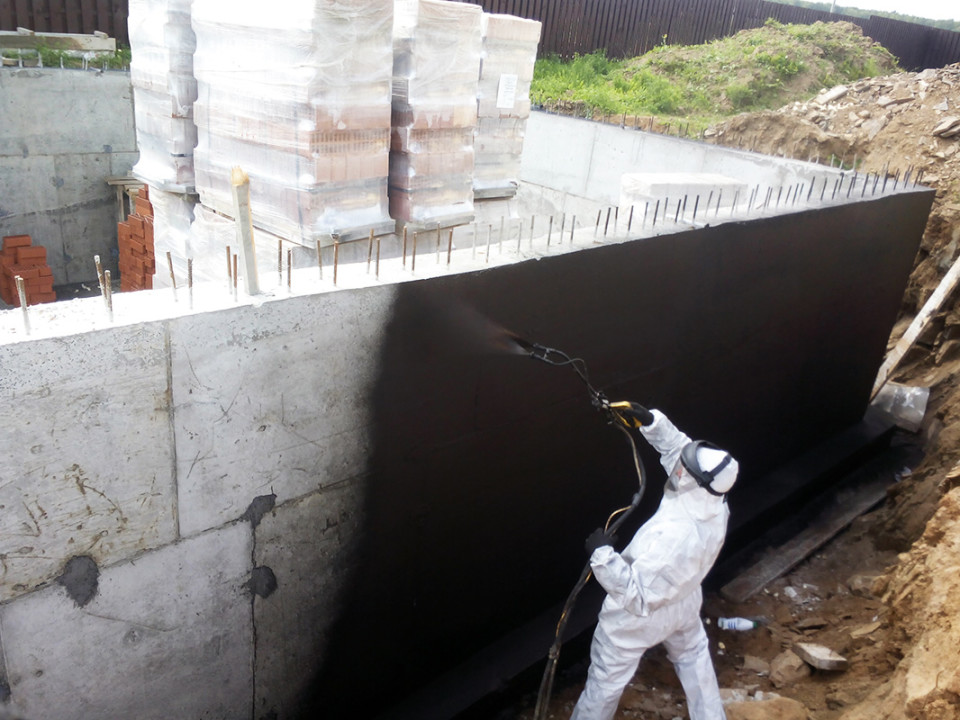
Polyurethane insulation
Polyurethane mastics are based on polyurethane, the main components of which are polyols, diols and diisocyanates. Thanks to the combination of these components, a waterproof, elastic and resistant to mechanical pressure coating is obtained at the output.
Method of application:
Polyurethanes can be applied by spraying through special equipment or manually with a roller and brush, having previously prepared the composition for application and mixing all the components in the correct proportion (if there are 2 or 3 component materials).
You can read more about polyurethane coatings in the article – “Polyurethane waterproofing”.

What can be done if waterproofing has not been done for the ribbon foundation?
If the house has already been built, a blind area, a storm sewer, a landscape has been completed, and then it turns out that the ribbon structure does not have horizontal or vertical waterproofing, then several actions can be taken here that differ in their approach to solving the problem.
In the absence of vertical waterproofing of the ribbon:
The house should be dug out, while violating the made blind area and the landscape around the house. After digging up the house, waterproofing is applied to the ribbon. Since the house has already been excavated, it is recommended to install a drainage system, which will divert water from the foundation, preventing it from being constantly in the water.
In the absence of horizontal waterproofing ribbon:
If your ribbon foundation does not have horizontal protection from water, then it is quite possible that through voids, capillaries and microcracks in concrete, water and moisture will rise through the tape up the slab or walls and appear as a wet spot or wet wall in the cold seam area of the floor and wall junction.
Having dug out the house, you will not get rid to the place, where it was necessary to perform horizontal or cut-off waterproofing, since it is located between the ribbon and the wall or between the ribbon and the slab. In this case, the only way to restore it is to use injection waterproofing.
Restoration of waterproofing by the method of injection
The injection system can be used from inside the room, when the house has already been built and put into operation. When restoring the horizontal insulation of the ribbon, work should be carried out in the area of the cold seam of the slab and the wall, that is what will help the injection compound penetrate deep into the cold seam and serve not only as its protection, but also as protection from the capillary rise of moisture from the bottom of the ribbon up the wall (which the horizontal waterproof system was supposed to serve).
When performing restoration work using injection, in order to achieve the most effective and long-lasting result, it is necessary to perform the following actions:
- It is necessary to reach the base of the cold seam (slabs and walls) – For this purpose, the edge zone of the finishing elements of the slab (tiles, screed) and walls (plaster, drywall and etc…) should be dismantled;
- Strengthening of the cold seam – in order for the injection resin to go deep into the injection, and not inside the room (through a weak joint), the seam is stitched, by performing a small indenting, and then layer-by-layer compacted with a special expanding sealant;
- Injection – injectors are installed in the wall structure at an angle of 45 degrees, so that when injecting, the resin gets exactly at the contact of the wall/slab and resin (where there should have been a horizontal cut-off) and fills this space.
You can read about the injection method in the article in detail – “Injection waterproofing”.
Scheme of horizontal waterproofing installation by injection:
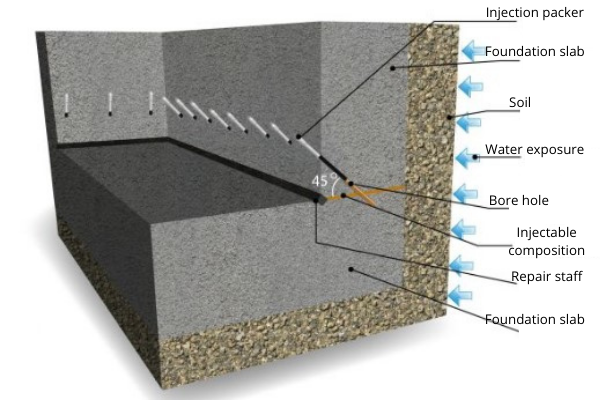
How to do best waterproofing of the ribbon foundation with your own hands?
In order to do work with your own hands, you need to know the principles of waterproofing, namely:
- Waterproofing is applied to horizontal and vertical surfaces;
- Waterproofing should be applied on a rigid base, not on soil or loose concrete;
- Before applying most materials, the surface should be cleaned and primed;
- When installing a waterproofing coating, it should be solid without weak seams or open areas between the membrane or mastic. If there are open places or weak seams, water will pass into concrete and under waterproofing carpet, violating its integrity and tightness;
- If you do not follow the installation instructions of a particular material at 100%, you risk that the work performed will become unusable at least at the first serious rain or temperature drop, and at most during first 3 years of operation.
Stages of independent execution of works:
- Material selection – If you decide to make waterproofing with your own hands, then it is recommended to choose a high-quality material for the installation of which you do not have to purchase special equipment or gain experience for a long time contributing to its correct application. Such a product can be high-quality bitumen mastic or single-component liquid rubber;
- Surface preparation – the surface is cleaned of dirt, and sharp corners and stones are knocked off;
- Applying a primer if necessary – A primer is a primer that improves adhesion (adhesion) between the base and the waterproofing coating. The primer is applied with a roller or brush;
- Waterproofing application – Applied strictly following the manufacturer’s instructions.
The scheme of the waterproofing installation of the ribbon structure of the foundation:

Where to buy high-quality waterproofing by yourself?
When buying waterproofing or any other building material on the market or from an unknown supplier, you risk running into the following consequences:
- Fake;
- Low quality;
- Goods, that were stored incorrectly in terms of temperature conditions and other nuances of storage, as a result of which they lost their properties;
- Overdue construction materials;
- Deception during delivery or its absence in principle (the supplier got the money and disappeared).
If you do the work with your own hands and order construction goods by yourself, then we, as experts, recommend that you turn to proven construction hypermarkets. These stores are located in any American city and have serious advantages, such as:
- Low prices
- Quality products
- Convenient online purchase, without visiting the store
- Delivery in 2 hours after the online application.
The price of waterproofing of a ribbon foundation
| Work description | Unit of measurement | Price in $ |
| The installation of surfaced roll sheets | m2 | 10 |
| Installation of a self-adhesive membrane | m2 | 10 |
| Application of mastic insulation in 2 layers | m2 | 11 |
| Application of liquid rubber in 2 layers | m2 | 11 |
| Application of cement-mineral 2-component mastic | m2 | 10 |
| The arrangement of polyurethane mastic | m2 | 20 |
| Application of cement compositions | m2 | 18 |
| Applying the primer | m2 | 8 |









